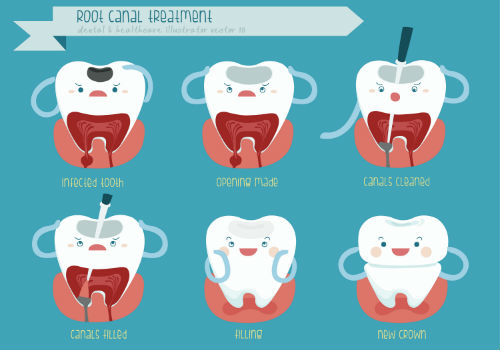Root canal treatment tends to have a poor reputation when it comes to dental procedures because many patients fear it may be a painful and traumatizing experience. In reality, the root canal process is the equivalent of receiving a filling and can fully restore your tooth, saving it from extraction.
When is root canal treatment needed?
Root canal treatment may become necessary when decay reaches the pulp of the tooth. The pulp houses the blood vessels and nerves for the tooth and when it develops an infection the tooth and the gums surrounding the tooth become extremely sensitive, triggering excruciating pain.
Sometimes trauma to a tooth may cause discoloration, or an abscess can occur indicating you require a root canal.
If you are experiencing extreme temperature sensitivity when eating or drinking, you may need to schedule a check-up with your dentist to assess the area.
I have an infection, can I be treated?
A root canal infection can be agonizingly painful, cause sleep disturbance, limit your ability to work or go to school and adversely impact your daily life. They can also be an immediate threat to your general health, so it is important you seek immediate dental care.
Your dentist may prescribe antibiotics to treat an infection before you can undergo root canal treatment. An active infection during a root canal treatment can inhibit the anesthesia from working and prevent the area from becoming sufficiently numb in order to treat the tooth.
It is critical you follow your dentist’s instructions for treating the infection before treating the tooth.

What is root canal treatment?
Root canal treatment is a standard dental procedure that is typically performed over one or two visits to your dentist. After the tooth is examined and numbed, your dentist will remove the infected pulp from the pulp chamber and the root canals through an opening in the crown of the affected tooth using special files.
Your dentist will then clean and disinfect the area before sealing with a biocompatible material. The opening is filled with a temporary filling, and you will return for a follow-up appointment to have a crown fitted in order to restore your you tooth to its full strength and functionality.
Will I still be in pain after a root canal procedure?
You should experience immediate relief after the removal of the infected pulp but may experience a little soreness in your jaw due to the length of the procedure which can take 1-2 hours.
Over-the-counter or prescription medication can alleviate any discomfort you may be feeling.
Can I develop an infection after root canal treatment?
Unfortunately, there is a small risk of an infection returning months or years after treatment. This is known as a failed root canal. Some returning root canal causes include:
- Undetected canals in the initial treatment.
- A crack in the tooth’s root that allows bacteria to enter.
- A cracked or broken crown that enables bacteria to enter the root.
- The breakdown of the inner sealant over time which allows bacteria to contaminate the inside of the tooth.
Can my tooth be retreated if I develop a secondary infection?
Retreatment of an infected root canal has a very high success rate. Your dentist will retreat the tooth to ensure the infection is eradicated. If you have a crown or the infection is obstructed by a filling, your dentist pay perform an apicectomy.
An apicectomy procedure involves making an incision in your gum so your dentist can access the root. They may remove part or all of the root to ensure the infection is gone before cleaning and disinfecting the site and stitching the area closed.
If the decay or damage to your tooth is too severe, your dentist may recommend an extraction. They will also discuss your options for missing tooth replacement to ensure your smile is aesthetic, healthy and functioning.

